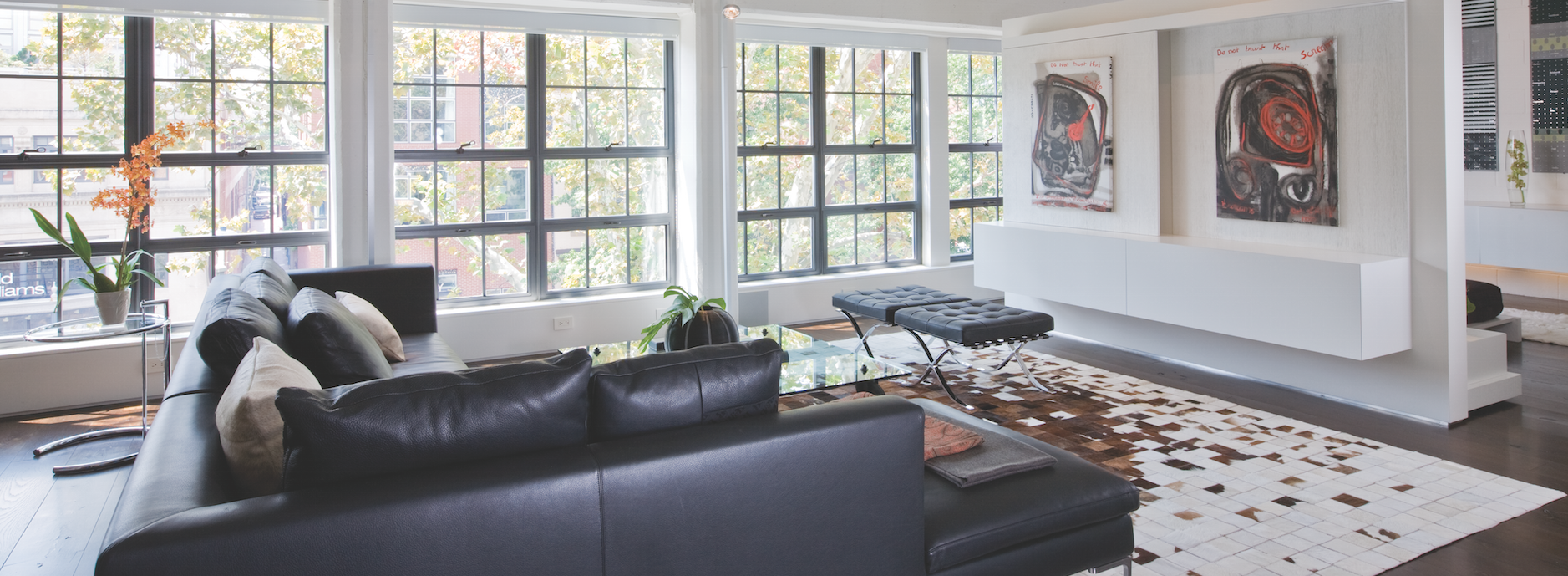- © 2025 Annapolis Home Magazine
- All Rights Reserved

When Ernesto Santalla, a Washington, D.C.–based architect and interior designer, signed on to renovate this loft for a globe-trotting couple, he knew that the focus had to be on the couple’s collection of contemporary art. The pair spends much of their time overseas and have amassed a collection that is as international as their lives. Paintings and sculptures have roots in Great Britain, the Netherlands, and Curaçao.
 Santalla conceived the design and much of the furnishings in his studio, Ernesto Santalla PLLC, creating an unusual charged stage seemingly simple and spare, but highly refined in design and execution. Consider the color palette. All of the walls and the ceiling are painted white. There’s a bit of stainless steel, black leather, chrome and glass and not much more. This is a good thing. These bold moves clear the fog of weak design and connect to the power of the art.
Santalla conceived the design and much of the furnishings in his studio, Ernesto Santalla PLLC, creating an unusual charged stage seemingly simple and spare, but highly refined in design and execution. Consider the color palette. All of the walls and the ceiling are painted white. There’s a bit of stainless steel, black leather, chrome and glass and not much more. This is a good thing. These bold moves clear the fog of weak design and connect to the power of the art.
The converted industrial space retains many original textures and Santalla has mixed in a few new ones. The old ceiling is cast concrete—a series of narrow barrel vaults run like a washboard across the width of the apartment. It was built solely for function decades before a very young I. M. Pei created the National Gallery, one of the great modernist buildings in D.C. defined by three concrete vaults.
Santalla incorporated the flat textures of walls and the mirror-like shine of the lacquered kitchen cabinets. Adding to the mix is an old steel I-beam, a bit bloated with decades of paint and a pair of old funnel-topped plumbing pipes at each end of the apartment. Santalla and the homeowners wisely resisted the impulse to box them in. An end wall of white cinder block provides more texture and a great backdrop for a large grid painting by British artist Keith Milow.
In front of the painting is a snappy custom partners desk designed by Santalla. A wonderful assemblage of boxes (white, of course) are topped with what seems like an acre of glass. Its base has been extended into a low-lying plinth for sculptor Nelson Carrilho’s ghostly, top hatted charioteer.
With Santalla doing double duty as architect and interior and furniture designer, the loft has an unusual degree of visual and stylistic integrity. The construction has the precision and imagination of fine furniture. There’s a wooden table that first appears to be a small island with seating for two. However, it’s cleverly tucked into an alcove and can be slid out to seat four.
 The sleeping area of the apartment is set off behind a partial wall that serves to anchor the custom-built bed and night tables. A pair of black and red abstract paintings hangs side by side: the one on the left seems to float out a few inches but is actually mounted on a raised panel that when slid open reveals a television.
The sleeping area of the apartment is set off behind a partial wall that serves to anchor the custom-built bed and night tables. A pair of black and red abstract paintings hangs side by side: the one on the left seems to float out a few inches but is actually mounted on a raised panel that when slid open reveals a television.
For clear, strong design to exist, there must be a space and place for everything. And, indeed, all has been taken into consideration. The white planes of the kitchen counters are only interrupted by a small sleek espresso machine. A long hallway of double height closets recedes with a Renaissance-like perspective. At their end, they intersect with a dressing area and a custom-built “packing” counter—again, white—
a nice amenity for the homeowners who needed a dedicated space to simply pack and unpack suitcases for ongoing international business travels.
The space is a study in contrasts. Countering the abundance of white are deeply hued wood floors of old growth chestnut wood. In the living area, there is a cowhide rug, designed by Santalla and custom made in Argentina; its natural markings become a mosaic that seems to explode from its dark center. The furniture that has not been custom designed is all classic modern. There is a pair of Knoll Barcelona ottomans designed by Mies van der Rohe in the 1930s and an iconic Eileen Gray glass and chrome side table. Eames chairs serve as both dining and desk chairs.
In the end, all of the simplicity and elegance of the architecture, the well-thought-out design with a place for everything, is not just about obsessive neatness. It is about raising the aesthetic stakes, assuring that the art collection with its larger than life sculptures, its paintings, whether rhythmic or emotional or cerebral, can breathe. When Santalla told me that “much of the design work here was about hiding what you didn’t want to see,” he was talking about audiovisual devices and mechanical equipment. But he also said that the art collection drove the design. The space he created ensures its powers reign.
Tom Levine writes about architecture, design, and culture. A resident of Annapolis, he holds a bachelor’s degree in art history from Boston University.
Resource:
Ernesto Santalla PLLC, ernestosantalla.com.
From Vol.7, No. 2 2016
Annapolis Home Magazine